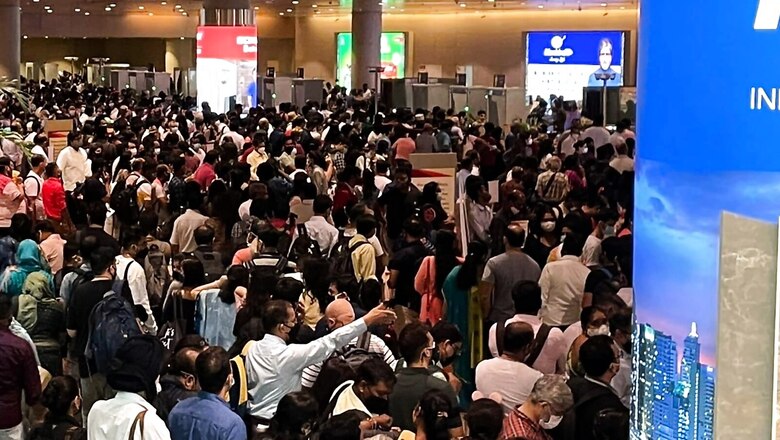
views
As countries around the world grapple with vaccination drives, health security and travel policies, a clear winner has been domestic tourism. As is the case with other markets, after the decimation of tourism demand due to the Covid-19 pandemic, the number of domestic travellers is gradually increasing. Folks are now exploring and discovering destinations within the country — from the foothills of Himachal to the beaches of Kanyakumari, from the natural beauty of the northeast to the temples at Palitana, and everything in between. India’s travellers that only 19 months earlier opted for foreign destinations over domestic ones are no longer doing that. Constraints on travel have helped nudge travel demand inwards. Whether this is transient or permanent remains to be seen.
A constraint driven opportunity
With 3.27 lakh passengers taking to the skies on October 18, this marked the busiest travel day since the start of the pandemic. Patterns of folks taking to the skies of flyers in packed airport terminals and of growing travel demand are once again becoming commonplace. So much so that airports such as Mumbai and Delhi have brought forward opening dates for domestic terminals towards meeting rising demand. Airports are once again witnessing the organised chaos that we are accustomed to. But there is one key difference. This time around, majority of this travel is driven by leisure demand.
Other proxies that speak to a revival of leisure demand are also trending upwards. Goa is likely to be the first city where 5-star hotels will yet again command pre-Covid rates very soon; Calcutta had healthy booking levels for the Durga Puja; and all indications are that Diwali bookings to cities such as Delhi, Lucknow, Varanasi and Jaipur are extremely strong.
There are also other behavioural changes. A recent clip from a business conclave went viral where an eminent historian made the point that India has to reclaim her history. The clip is quite telling. Because the theme resonates with a feeling of exploring India’s heritage and historical landmarks. This is a trait that was not earlier seen in the context of travel demand. While reasons are many, the advent of social media has certainly helped. For the portion of the population that travels, each morning brings with it a slew of WhatsApp messages and several of these now speak to heritage, to architecture, to nature, to destinations and consequently to demand. At the very least, they pique interest by enhancing awareness. Of sights and sites previously unexplored. Exploration has been a core behavioural trait for the Indian consumer and with continued closure of international skies, restrictive visa and arrival policies and the increased cost of international travel, a constraint driven opportunity has emerged.
A one-time opportunity for hotels, airlines, cities
In 2019, 27 million Indians travelled overseas and spent an estimated $25 billion. Given that the international travel by most estimates will not return with full-force prior to 2023, a large portion of this demand is now up for grabs. And a large portion of this demand is turning inwards. It is an opportunity that the hotels, airlines and cities (or even states) simply cannot afford to miss.
Arguably, international travel was and is as much about escape as it is about exploration. Escape from the daily challenges faced by the populace and exploration of a new destination. As such for hotels, airlines and cities, a focus on both aspects is necessary. The softer aspects usually attract or detract one from destinations and this is often glossed over. It cannot be forgotten that India’s citizens travel to foreign destinations both as a chance to explore and also as a respite.
The softer aspect becomes even more critical for certain cities that are starved of tourism products that can deliver at scale. The absence of such tourism products led to the obsession with malls, an indoors culture and a failure to diffuse the richness of regions across to the domestic traveller. The pandemic has brought about a reset of sorts and the opportunity to reclaim the consumer and the traveller awaits. So while cities focus on connectivity and infrastructure, which are indeed growing by leaps and bounds, there must also be tourism sites and experiences that can be developed. And it is worth repeating that the softer element cannot be glossed over.
The elusive recurrent traveller
For cities and travel providers, the challenge is to convert the travel from a one-time visit to a recurrent visit. This in turn translates to jobs, economic outcomes and growth. For India, tourism in 2019 touched almost 10% of gross domestic product (GDP), and domestic tourists alone numbered well in excess of 2 billion. The drivers for this vary. From religious travel to experiential travel there are many segments and the challenge for destinations is to provide and experience that has the traveller returning frequently, throughout the year and make for recurring revenue. Perhaps the best example is Goa which over the years has positioned itself as an all-weather destination and has a significant portion of recurrent demand. As an airline executive recently remarked, “You can never have too much capacity to Goa.” And indeed flight schedules are proof of the same – tempered only by the constrained capacity at the airport. Other destinations like Rishikesh, Shillong, Gangtok, Leh and Coorg are also fast growing but work towards capturing recurrent demand remains.
As the country comes closer to a post-pandemic reality, tourism will be a key driver of success. And a key element of growth. Constraints on international travel have helped create a once-in-a-lifetime opportunity. Tourism has taken a great turn inwards and it is now up to cities and travel providers to capture the hearts and minds of the Indian traveller.
The writer is the managing partner at aviation services firm AT-TV. The views expressed in this article are those of the author and do not represent the stand of this publication.
Read all the Latest News , Breaking News and IPL 2022 Live Updates here.



















Comments
0 comment